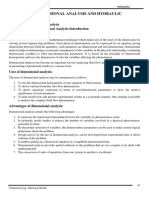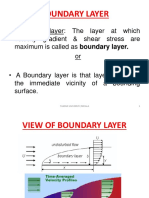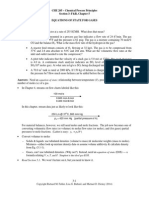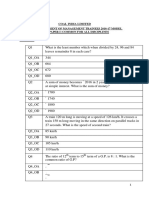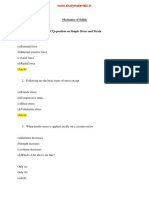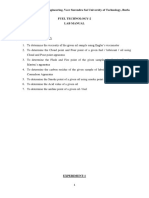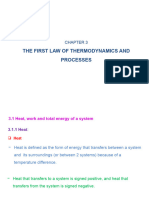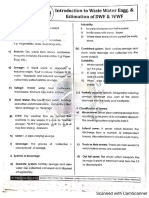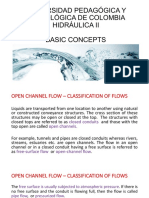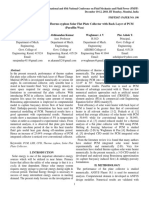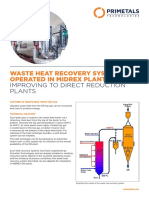Hydraulics
Prof. B.S. Thandaveswara
6.1 Energy and Momentum Coefficients
Generally, in the energy and momentum equations the velocity is assumed to be steady uniform and non-varying vertically. This assumption does not introduce any appreciable error in case of steady (or nearly uniform) flows. However, the boundary resistance modifies the velocity distribution. The velocity at the boundaries is less than the velocity at a distance from the boundaries. Further, in cases where the velocity distribution is distorted such as in flow through sudden expansions/contractions or through natural channels or varying cross sections, error is introduced. When the velocity varies across the section, the true mean velocity head across the section, 2 2g 2
)m , (the subscript m indicating the mean value) need not necessarily be
equal to V
2g . Hence, a correction factor is required to be used for both in energy
and momentum equations (See Box). The mean velocity is usually calculated using continuity equation. Keulegan presented a complete theoretical derivation of energy coefficient proved that the selection of
and
and (Momentum coefficient) depends solely on the
concept of the coefficient of friction which is adopted. If the equation of motion is derived by the energy method, the concept underlying the friction coefficient in that equation is that of energy dissipation in the fluid per unit length of channel and factor to use. To understand proper use of factors momentum principle is used appropriately. Box: The weight of flow through an element of area dA is equal to g dA ; the kinetic energy 2 per unit weight of this flow is V 2g ; The rate of transfer of kinetic energy through this element is equal to 2 g 3 g dA . = dA (1) 2g 2g Hence, the kinetic energy transfer rate of the entire flow is equal to A 3 dA (2) g 2g 0
Indian Institute of Technology Madras
is the proper
and and the energy principle or
�Hydraulics
Prof. B.S. Thandaveswara
and the total weight rate of flow is equal to g dA
g Q = g VA
mass volume kg x m3 = kg mass = * volume = 3 m Force = N = mass * acceleration mass density = = kg * m s
2
kg m s2 kg m
3
specific weight = g =
m s
2
N m3
Velocity v Real
Velocity v ideal
Velocity distribution along section AA
Velocity distribution in a Trapezoidal Section
The mean velocity is by definition equal to Q / A. Hence, the mean velocity head, or kinetic energy per unit weight of fluid, is equal to A 3 dA 2 2 V 0 2g = = (3) 2g 2g VA m in which is a correction coefficient to be applied to the velocity head as calculated from the mean velocity. It is also known as the Coriolis coefficient. Hence N A 3 i3dA dA i =1 = 0 3 i = 1.....N (4) 3 V A V A Similar approach can be applied for computing the momentum term VQ . The rate of transfer of momentum through an element of area dA is equal to V 2dA ; Following similar logic as above the momentum correction coefficient can be obtained as
A 2 dA 0 i =1
i2dA
(5)
i=1,2....N 2 V A V A is also known as Boussinesq coefficient. 2
Indian Institute of Technology Madras
�Hydraulics
Prof. B.S. Thandaveswara
In general, the coefficients are assumed to be unity for channels of regular geometrical cross sections and fairly straight uniform alignment, as the effect of non uniform velocity distribution on the computation of velocity head and momentum is small when compared to other uncertainties involved in the computations. Table shows the values of and
and for selected situations.
Table: Values of
and for selected situations (after Chow, 1958)
Minimum 1.03 Maximum Average 1.07 1.05 Maximum Average 1.20 1.15
Channel Minimum Regular channels, flumes, spillways Natural streams and torrents River under ice cover River valley, over flooded 1.10
1.15
1.50
1.30
1.05
1.17
1.10
1.20
2.00
1.50
1.07
1.33
1.17
1.50
2.00
1.75
1.17
1.33
1.25
The kinetic energy correction factor expressed as (see box).
and momentum correction factor can be
A 3 dA 0 = 3 V A
A 2 dA 0
i =1
i3dA
V A
i =1 3
i = 1.....N
(4)
i2dA
V A
2
V A
i=1,2....N
(5)
Indian Institute of Technology Madras
�Hydraulics
Prof. B.S. Thandaveswara
6.1.1 Determination of and
Many investigators have done extensive investigations on the computation of Chow (1958) has summarised different equations for determination of various velocity distributions.
and .
and for
Rehbock assumed a linear velocity distribution and obtained
= 1+ 2 = 1+ 2
3
and for logarithmic velocity distribution.
= 1 + 3 2 2 3 = 1+ 2
V in which = max 1 , Vmax is the maximum velocity and V is the mean velocity V
If the velocity distribution is along a vertical is logarithmic, then the relation between and
, as shown by Bakhmateff, is that exceeds unity by about one-third of the
amount by which
exceeds unity. If 1 + n and 1 + 3n then =
+2
3
approximately. Generally, the coefficients
and are greater than one. They are
both equal to unity when the flow is uniform across the section, and the farther, the flow departs from uniform, the greater the coefficients become. The form of Equations (4) and (5) makes it clear that given channel section,
is more sensitive to velocity variation than , so that for a
> . Values of and can easily be calculated for
idealized two-dimensional velocity distributions.
Indian Institute of Technology Madras
�Hydraulics
Prof. B.S. Thandaveswara
y Velocity Distribution = 0 y 0 0
n +1 3 ( n + 1) = 3n + 1 2 ( n + 1) = 2n + 1 1 ( n + 3)( 2n + 1) = 1 ( 3n + 1) v=
1 7 = 1.043, = 1.015 If n =
The high value of
appropriate to laminar flow is of limited interest, since laminar flow seldom , the question
is rare in free surface flow problems. For turbulent flow in regular channels exceeds 1.15. In view of the limited experimental data on values of
always arises whether the accuracy attainable with channel computations warrants its inclusion!. A practical method of arriving at the values of
and for other than and idealised
velocity distribution is a semi graphical and arithmetical solution based on planimetered areas of isovels plotted from data measurable at the cross section. Measured velocities are plotted to draw the Isovels. The Isovels are constructed for each cross section and cross sectional areas, A , of each stream tube are calculated with planimeter and computations performed.
6.1.2 The Methods of computation of and may be classified as 1. Theoretical Methods
Based on experimental studies Strauss in 1967, has given empirical formulae for computing
and for general channel section based on the velocity distribution
given by the following equation.
Indian Institute of Technology Madras
�Hydraulics
Prof. B.S. Thandaveswara
V=ay1 n
in which v is the velocity at a point located at a height y from the bed a is a constant and n is an exponent such that 1 n .
and can easily be computed using following equations , if the velocity distribution
is known.
A 3 dA 0 = 3 V A
A
dA
2 V A
Strauss states that the general velocity distribution of the type given by above equation covers all possible distributions by suitably choosing the value of n. In the limiting case when n the velocity distribution tends to become rectangular. At the other extreme when n=1, the velocity distribution is linear for which case Strauss showed that
= 2 and =1.33.
= f ( n,1 ,B1 , 1 ) = f ( n,1 ,B1 , 1 )
in which n is the exponent of the velocity distribution, and, 1 is normalized depths, B1 is the normalized width of free surface to bed width,
1 is normalized bed width of berm
T b
(including) to channel bed. The velocity distribution plays a dominant role in influencing
and and in trapezoidal channel in addition to B1 = . For rectangular channel the
exponent n of velocity distribution has a dominating effect. But Strausss method has limited practical utility. It is not always true that the same velocity distribution prevails along all the verticals of the cross-section, especially in non-rectangular channels. Also
Indian Institute of Technology Madras
�Hydraulics
Prof. B.S. Thandaveswara
this method is not applicable when there is a negative velocity zone over the crosssection as in the case of a diverging channel, a bend or a natural channel.
y
depth of flow y Theoretical uniform flow Linear velocity distribution velocity (Ideal) distribution Power Law
Logarithmic velocity distribution
Typical velocity distribution
2. Graphical Method
In Velocity area method, the flow area is divided into number of grid cells and local velocities are measured using one of the measuring devices and finally integrating one will get the average velocity. The velocities are measured at the intersecting grid lines (nodes). Example: a1, b1, c1 etc......a5, b5.......e5. The average velocity over the elemental area is vcell.
Indian Institute of Technology Madras
�Hydraulics
Prof. B.S. Thandaveswara
e 1 2 3
dy dx
4 5
Grid for measuring Velocity
i
i+1
j+1
Co ordinates of the nodes are (i, j), (i+1, j), (i+1, j+1), (i, j+1) Corresponding velocities are v (i, j), v(i+1, j), v(i+1, j+1), v(i, j+1) v(i, j) + v(i+1, j) + v(i+1, j+1) + v(i, j+1) _ Average velocity of the cell vcell = _______________________________________ 4
Average velocity of the flow
1 v = v dy *db A00
by
vcell dA A ( = by )
in which dA is the elemental area of the cell
The other alternative is to draw the isovels (isovel is a line having the same value of velocity sometimes it is also known as isopleths) assuming the linear variation between two values and interpolating the value in between two nodes. It may be noted that the velocity would be zero on the solid boundary. Hence the gradients are sharper very close to the boundary. Typical isovels are shown in Figure. In this method, velocities are measured at several points of cross-section and the lines of equal velocities called isovels (also called isotachs) are drawn as shown in Figure.
Indian Institute of Technology Madras
�Hydraulics
Prof. B.S. Thandaveswara
Q = 17.95 l/s y = 0.332 m 0.3639 = 1.041 = 1.01
0.3505 0.2987 0.2499 Graphical Method
While drawing isovels it is assumed that the velocity varies linearly between two points. Next the area within each isovel is plain metered. Assuming that the velocity through the area bounded by, two isovels is equal to the average of their values calculated using the following expressions.
and and are
Indian Institute of Technology Madras
�Hydraulics
Prof. B.S. Thandaveswara
a1
a2
a3
a4
v Vs elemental area
v2
v3
Graphical Method of determining and (
av ,
av2 ,
av3 )
dA 3dA
3
AV
AV
(4) and
2dA
2
2dA
A
AV
AV
(5)
Indian Institute of Technology Madras
�Hydraulics
Prof. B.S. Thandaveswara
Rehbock used a graphical method and reduced the computational work in the above procedure. After planimetering the areas within each isovel, he plotted the curves of v,v2, and v3 against the corresponding planimetered areas as shown in Figure. It is evident that the areas under v2, and v3 curves are equal to respectively. V ,
3dA
and
2dA
and are computed as shown in the box.
12 8 4 0 0 1 2 v, m/s 3
Shaded area = A0
12 8 4 0 0 12 8 4 0 0 4 8 12 16 20 v3, m3/s3 2 8 6 4 v2, m2/s2
Shaded area = A1
10
Shaded area = A2
24 28
__ Graphical method of computing V, and
Indian Institute of Technology Madras
�Hydraulics
Prof. B.S. Thandaveswara
Shaded areas A 0 , A1, A 2 are planimetered. The average velocity V = v dy=
1 y
shaded area A 0 y shaded area A1
2
Similarly, = and =
V y shaded area A 2 V y
3
6.1.3 Grid Method
In this method, the flow area is divided into suitably chosen grids an velocities at the centers of gravity of these grids are measured as shown in Figure 3. Assuming that the effective velocity through each grid is equal to that at the center of gravity of the grid, the quantities
da ,
2da , 3 da
are computed. In particular if the grids are so
chosen that their areas are equal, the computational work become relatively easier. However, for greater accuracy the size of the grid should be chosen as small as possible. Also near the boundaries, relatively smaller grids are to be chosen. The advantage of this method is that it is less time-consuming than the graphical method as the actual velocities need not be calculated and isovels need not be drawn. . For purposes of comparison,
and for rectangular channel shown in the above figure
are computed by this method and are given in the following Figure.
Indian Institute of Technology Madras
�Hydraulics
Prof. B.S. Thandaveswara
0.325
0.364
0.378
0.338
0.364
0.366
0.357
0.364
0.365
0.361
0.364
0.361
0.35
0.364
0.364
0.333
0.357
0.359
0.2188
0.262 Q = 17.95 l/s y = 0.332 m = 1.041 = 1.024
0.252
Grid Method
Indian Institute of Technology Madras
�Hydraulics
Prof. B.S. Thandaveswara
6.1.4 Methods based on the use of empirical formula
Assuming a linear velocity distribution law Rehbock has proposed the following formulae for approximate values of
and .
= 1+ 2 ; = 1 +
In which =
2 3
max
V
Assuming a logarithmic velocity distribution law proposed the following expressions.
= 1 + 3 2 2 3 ;
= 1+ 2
In which max is the maximum velocity and V is the mean velocity. It should be noted that the above approximate formulae are applicable only when the flow is free from any reverse flow occurring over any part of the cross-section of flow.
6.1.5 Computation of and for Reverse Flow
In case of the reverse flow one of the four methods presented above is directly applicable. If the reverse flow is occurring over any part of the cross-section of the flow,
and can be calculated using either the graphical or the grid method. While using
these methods it should be noted that the velocity in the reverse flow region should be assigned a negative sign and all the computations should be done taking the sign also into consideration.
6.1.6 Values of and
Actual values
in Several Practical Cases
and in many practical cases (which are frequently met with in
Hydraulic Engineering) are presented in Table I. Some of these values are listed by OBrien and Hickox OBrien and Johnson and King. They are reproduced here along with several other cases for the sake of a comprehensive table of
and values.
Indian Institute of Technology Madras
�Hydraulics
Prof. B.S. Thandaveswara
Sl. No. width (m) 1 0.60
Channel Dimensions
Hydraulic elements Area (m2) 0.519 Critical depth (m) 0.198 Mean velocity (m/s) 0.320
Coefficients
Remarks
Max.de pth (m) 0.862
Hydraulic Radius (m) 0.222
Graphi cal 1.20
Rehb ock 1.10
Grap hical 1.07 Rectangular channel 0.9144 m above weir and obstructions upstream Simson Tunnel - centre of straight reach 49.98 m long Horse shoe conduit straight reach Rhine 365.76 m below bridge on a long curve Sudbury Aqueduct with a bottom slope 0.000189 Computed with Bazin series 10 Computed from Nikurade's data Series (E) schoder and Turner Series (I) Schoder and Turner - Run 54 to 58. Series I ibid Series I ibid Series D Schoder and Turner Runs 101 to 105 Series D, L, M. Schoder and Turner Triangular channel Trapezoidal channel Pipe Shallow ditch Natural channel Experiment number 2C Rajaratnam Muralidhar
1.00
0.862
0.3250
0.895
0.216
0.53
1.22
1.20
1.08
3 4 5 6
1.00 1.01 10.54 1.987
0.874 0.429 3.23 1.50
0.3249 0.2316 1.86 0.6309
0.893 0.431 23.27 2.898
0.219 0.496 1.42 0.76
0.365 2.56 1.01 1.48
1.41 1.07 1.10 1.07
1.37 1.04 1.07 1.03
1.12 1.03 1.05 1.034
7 8 9 10 11 12 13 14 15
159.4 2.59 2.67 2.74 2.71 2.65
3.81 1.38 1.22 0.914 0.618 0.460 0.264 0.244
2.438 0.6949 0.6492 0.548 0.411 0.326
4.055 3.429 3.009 2.19 1.415 1.014 0.053 0.0366
1.91 0.685 0.658 0.600 0.53 0.499 0.35 0.14
1.024 0.886 0.874 0.792 0.658 0.569 2.31 0.205
1.35 1.06 1.04 1.04 1.04 1.04 1.161 1.138 1.07
1.43 1.02 1.04 1.03 1.02 1.03
1.121 1.01 1.014 1.014 1.010 1.012
1.286
0.762
16 17 18 19
1.286 1.286 1.286 1.286
1.524 1.524 1.524 3.07
1.08 1.60 2.08 1.80
20 21 22 23 24 25 26
1.286
2.743
2.00 1.528 1.665 1.365 1.460 1.422 1.105 1.225 1.085 1.164 1.136 1.222
0.45
0.0911
Indian Institute of Technology Madras
�Hydraulics
Prof. B.S. Thandaveswara
27 28
0.45
0.350
3.72 1.76
2.14 1.41
29
0.61
15.40
5.00
30
3.87
31
7.40
Diverging channel Rectangular open channel bend Maximum and in a hydraulic jump with an inflow Froude number of 7.4. At the outlet section of a draft tube Spiral flow under a model turbine wheel
(Serial No. 1 to 20 are from O'Brien and Johnson, Enr, Vol. 1113, page 214 - 216, 1934 August 16 th after Jagannadhar Rao and others). From the table it may be seen that
values are larger in non-rectangular channels are
compared to rectangular channels and also that the values for natural channels are as high as 1.422. When there is a reverse flow in the cross-section, the values of
still larger. The value in the case of a diverging channel is 3.72. For spiral flows a value of
as high as 7.4 has been quoted . All these examples show that there are several and in hydraulic flow computations for a
practical cases in which the neglect of
proper assessment of energy and momentum at any flow section may lead to large errors.
6.1.7 Variation of and along the Hydraulic jump
The variation of
and along the length of hydraulic jump is given in figure below.
Jagannadha Rao (1970) conducted the experiments in a flume of 0.6 m width at Indian Institute of Technology, Kharagpur. The data given is for the case of a hydraulic jump with an approach flow Froude number of 7.4.
Indian Institute of Technology Madras
�Hydraulics
Prof. B.S. Thandaveswara
16 14 12 10 8 6 4 2
- 0.25
0.25
0.5 x ______ y2-y1
0.75
1.0
15 10 5 0 - 0.25 0
Jump Profile Roller Zone
0.25
0.5
0.75
1.0
x ______ y2-y1
Variation of
and along the hydraulic jump
Indian Institute of Technology Madras
�Hydraulics
Prof. B.S. Thandaveswara
6.1.8 , for Flow in Natural Channels
The natural channels can be subdivided into distinct regions, each with a different mean velocity.
Isovels in a single channel is nearly 1.15 3 Berm 2 1 Berm
2 Main channel (MC) 1 and 3 channel in the flood plains natural channel: River 2.0
Typical Cross Sections of natural channel
3 3 3 1 A1 + 2 A2 + 3 A3 =
( A1 + A2 + A3 )
2 3 12 A1 + 2 A2 + 3 A3 =
V V =
( A1 + A2 + A3 )
1 A1 + 2 A2 + 3 A3
( A1 + A2 + A3 )
4m 1
n = 0.035
n = 0.035
1 10 m
2.5 m 10 m
n = 0.015 5m
1 3 S0 = 0.001
COMPOUND CANAL CROSS-SECTION
This is particularly true in time of flood, when the river overflows on to its flood plains, or "berms,". These are known as Compound channel. In this case there are in effect three
Indian Institute of Technology Madras
�Hydraulics
Prof. B.S. Thandaveswara
separate channels. The mean velocity over the berms will be less than that in the main channel (MC), because of higher resistance to flow (basically due to, smaller depths over the berms , and due to the higher roughness in the berms. This variation in mean velocity among the different flow zones (Main channel and berms) is mainly responsible for values of much higher than those produced by gradual variation within a given section, so much higher as virtually to nullify any contribution to the value of
produced by gradual velocity variation. However, it is usually accurate enough to compute by assuming the velocity to be constant within each subsection (zone) of the waterway; then the following may be written.
3 3 3 1 A1 + 2 A2 + 3 A3
( A1 + A2 + A3 )
3 3 3 1 A1 + 2 A2 + 3 A3 1 A + 2 A2 + 3 A3 1 ( A1 + A2 + A3 ) A + A + A
(13 A1 + 23 A2
(1 A1
(i Ai )
3
3 + 3 A3
) ( A1 + A2
3
+ A3 )
+ 2 A2 + 3 A3 )
N 3 N 2 i Ai Ai = i = 1 N i = 1
i=1
Similarly expression for can be obtained.
=
A + 2 A2 + 3 A3 in which V = 1 1 . A + A2 + A3 1
2 2 2 1 A1 + 2 A2 + 3 A3
( A1 + A2 + A3 )
When flow resistance formula (Manning, Chezy, other formulae) is combined with the above equations numerical values of situations. Generally, the
, may exceed much higher than 2 under certain
value is taken as 1.0 when the information is lacking.
Indian Institute of Technology Madras
�Hydraulics
Prof. B.S. Thandaveswara
References: 1. Chow Van Te Open Channel Hydraulics, McGraw Hill Publications, 1958. 2. Henderson F.M. Open Channel Flow, MacMillan Publishing Company, 1966. 3. Jaganadha Rao, M.V., Lakshmana Rao, N.S., and Seetharamiah, K. "On the use of Energy and Momentum coefficients in Hydraulic flow computations" - Journal - Irrigation Power CBIP , Volume 27, part- 3, pp 315 - 326, 1970. 4. Strauss.V. The Kinetic Energy Correction Factor and the Momentum Correction Factor in Open Channels. Proceedings of Twelfth Congress of I.A.H.R., Vol.1, Sept 1967,pp.314-323. 5. O' Brien, M.P. : "Discussion on stream flow in general terms" by Casler", Trans. A.S.C.E. Vol. 94, 1930, pp. 42 - 47. 6. O' Brien, M.P. and Johnson, J. W. : "Velocity Head Connections for Hydraulic Flows". Engineering News Record. Vol. 113, No. 7, pp. 214 - 216, Aug. 16, 1934.
Indian Institute of Technology Madras












